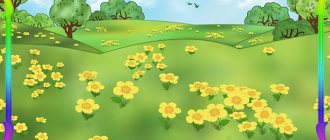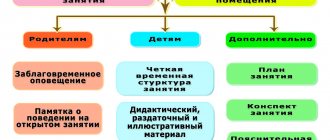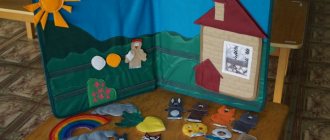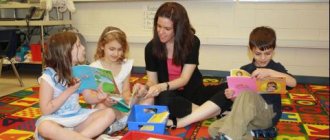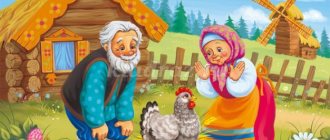Open integrated lesson in the senior group. Works by Marshak
Integrated lesson for children 5-6 years old. Topic: “Journey through the works of S.Ya. Marshak."
The author of the lesson is teacher Vesnina O.V.
Integration of educational areas: Social and communicative development, artistic and aesthetic development. Problem: Today, more than ever, preschool institutions are faced with the problem of developing a child’s interest in books. Modern children are moving away from books, preferring computers and televisions. Goal: To arouse children's interest in the works of S.Ya. Marshak. Objectives: - Summarize children’s knowledge about the writer and his works.
— Continue teaching children to memorize poems and improve their ability to solve riddles. - Develop children's artistic abilities. — Develop emotionally expressive speech. — Develop artistic and creative abilities in productive activities. Progress of the lesson:
Introductory part: (Children enter the beautifully decorated hall. The hall is decorated with children's drawings from the works of S.Ya. Marshak).
Hello guys! I see that you are all so beautiful, you are in a wonderful mood, because it’s so good that we are all gathered here today! Everyone is assembled - children are adults. We can begin. But first we need to say hello to everyone! (we say hello) Main part:
Educator:
Guys, look at our wonderful screen.
Who is shown in the portrait? Children's answer - (S.Ya. Marshak) Educator:
Correct!
This is the great children's writer S.Ya. Marshak. He lived for 77 years, you know his books, your mothers, fathers, and even grandparents knew him. And today I want to invite you on an exciting journey to the land of fairy tales and poems by Marshak. We will wake you up to remember and read the kind, cheerful works of this wonderful writer. And what we will take on this journey, you will have to guess. What kind of miracle? Blue house, Blue windows all around, Wears shoes with rubber And eats gasoline. (bus) (Children guess the riddle, we all get on the bus, the driver is chosen with Marshak’s counting, and everyone goes on a trip to the song “we eat, we eat, we eat”). Station "Vokzal" Educator:
Oh, guys, what's going on there?
What's that noise? (A lady in a hat and with a purse runs in) Robbers, thieves, freaks The dog is the wrong breed......give me back my little dog. Educator: Guys, do you know who this is? Children's answer: (Lady). Educator:
What work is this heroine from?
Children's answer...(Luggage) Educator: Let's remember the first lines of this poem. Children’s answer….(The lady checked in the luggage - a sofa, a suitcase, a travel bag…..etc.). (The Absent-Minded One enters). - “Deeply respected, respected carriage...etc.” Educator:
Look who it is?
And how strangely he is dressed. Children: Instead of a hat on the go, He put on a frying pan Instead of felt boots, gloves He pulled on his heels That's what an absent-minded one is from Basseina Street!!! Educator:
Guys, who is this?
Children: (Abstract). Educator:
We continue our journey.
"Station "Riddle". Educator:
Do you know that S.Ya.
Marshak came up with various riddles for children like you. Let's try to guess them (show slides with riddles). 1 riddle - (glasses).2- (saw). 3- (boots).4- (matches). Do you remember that matches are a very dangerous object? Children...answers. (The numbers 01 appear on the screen) Educator: What are these numbers? Children...answers. Educator:
Every citizen remember the firefighter number... Children - 01.
Educator:
Which work by Marshak are these lines from?
Children - "Fire". Educator:
Fire is our friend, but not always, it can cause trouble!
5-riddle - (calendar). (On the screen is a diagram of times and months of the year). Educator:
S. Ya Marshak has a poem “All Year Round,” remember?
We open the calendar... Children - January begins (name all the months of the year in order) Educator:
Guys, now everyone come to me.
Do you know that every season has its own fairy. And today one of the fairies came to us, but what time of year the fairy is visiting us, we will now guess. (The piece “Spring Fairy” is played; children listen and guess). Educator:
Guys, we need to continue our journey.
Station “Songs and Nursery Rhymes” Educator:
S.Ya.
Marshak lived and studied in England at the University of London and traveled a lot around the country. During these trips, he recorded many different songs and nursery rhymes, but they were all in English. And so that we could read them, Marshak translated them into Russian. Here, for example, is the long-known song “Humpty Dumpty.” Maybe someone wants to tell this song? (Children tell) Educator: - Another song “Little Fairies” (Children tell) Educator:
- And Gleb will help me show the nursery rhyme “Greedy” (we show).
Phys. just a minute. Guys, we all remember the work “Ball”, so we will not only tell you about it, but also show it. My cheerful ringing ball (jumping on two legs) Where did you run off to jump Red, blue, blue (jumping with alternating right and left legs) Can’t keep up with you I clapped you with my palm (claps your hands) You jumped and stomped loudly (we stomp our feet ). (A sparrow can be heard chirping.) Educator:
- Guys, what is that sound?
Children: - it’s a sparrow tweeting. Educator:
- Where did the sparrow have lunch?
Children: - At the zoo with the animals! Educator:
- Do you want to visit the zoo?
Children - Yes Teacher:
- Then let's go!
“Zoo Station” Educator:
Guys, let’s guess who the sparrow had lunch with?
(The voices of wild animals are heard, children listen and guess). Station "Theater" Educator:
- Do you want to go to the theater?
Children: - Yes Teacher:
- Come on in.
(A squeak is heard. Get the mouse toy) Educator: - How small you are, you must have gotten lost, where did you come from? Children: - This is a mouse from the work “The Tale of the Stupid Mouse.” Educator:
- Let's watch this fairy tale.
And our children will show it to us. (screening of the theatrical performance “The Tale of a Stupid Mouse”). Educator:
- Well, guys, our journey is coming to an end, and we need to return to our kindergarten.
(we get on the bus and return) Educator: - Here we are in kindergarten. (knock on the door) Educator:
- Who is knocking on my door with a thick bag on his belt?
Children: - It’s him, it’s him, the Leningrad postman! (The postman brings a book) Educator:
Look what a beautiful book, all the pages are multi-colored!
Children: - This is a Multi-colored book. Educator:
- Yes, exactly, this is a Multi-colored book.
Who is the author of this book? Children: - S.Ya. Marshak Teacher:
- Well done!
Oh, but look, there is not a single illustration in this book, what should I do? Or maybe we can paint it ourselves? (Children's answer). Practical part: (Children color the pages and present the drawings to the guests. Reading poems from the Multi-Colored Book) 1 page (green) This page is green, which means it is permanent summer….i.t. d. page 2 (yellow) Here is the yellow page, Desert Country...etc. d. 3 page (blue) This page is sea, You won’t see land on it...etc. d. 4 page (red) This page is red, Red sun, red summer...etc. d. 5 page (black) This page is at night, The capital is shrouded in darkness... etc. d. 6 page (white) This white page, Here a fox walked along it... etc. Educator :
What a wonderful, bright, colorful book we got, well done!
And now I have a little surprise for you. I want to show you the filmstrip “Baggage” in which you will hear the voice of S.Ya. Marshak. (View). FINAL PART. Educator: My dears, please tell me where we went today? Which writer's works do you remember? Name these works for me? How did the colorful book help? What did you like most? (children's answers). Educator:
Our journey has ended! Let's say goodbye to our guests! All together: GOODBYE.
We recommend watching:
Integrated lesson for children of the senior group Integrated lesson with a presentation for children of the senior group on the topic: Autumn Summary of an open lesson on familiarization with fiction in the senior group. Abstract of an integrated educational activity on cognitive development in a group of senior preschool age on t
Similar articles:
Summary of an integrated lesson in the senior group of kindergarten. Days of the week
Summary of a lesson in the senior group on the topic “Desert”
Abstract of GCD in mathematics in kindergarten in the senior group. Length, height, width of objects
Summary of an integrated lesson on the topic “Animals” in the senior group
Lesson summary - travel for children of the senior group of preschool educational institutions on the topic: Birds
Lesson notes on the works of S.Ya.Marshak.
Lesson notes on the works of S.Ya.Marshak.
Objectives: 1. Expand the understanding of the life and work of the famous writer and translator S. Ya. Marshak.
2. To develop children’s creative abilities in the theatrical field, imagination, coherent and expressive speech based on the works of S. Ya. Marshak.
3. To develop in children the ability to speak in front of an audience, develop communication skills, and form a friendly attitude towards each other.
Equipment:
Musical recordings, treats;
Exhibition of books based on the works of S. Ya. Marshak, his portrait;
To stage the poem “Gloves” - gloves, table, chairs, dishes, cake;
For playing ball.
Children enter the hall to the music of “Where the Wizards Are.”
Host: Hello guys! Today I invited you to a literary evening. But before we start, I would like to ask you. Have you heard such a poem? Reads out poems: “Children in a cage.”
Children read: “Tiger Cub”, “Elephant”, “Giraffe”, “Camel”, “Ostrich”, “Zebras”, “Polar Bears”, “Owls”, “Penguin”, “Swan”, “Eskimo Dog”.
Host: Do you know who wrote these poems? They were written by Russian children's writer Samuil Yakovlevich Marshak. He lived a very good life and did a lot for children. Samuil Yakovlevich loved children very much, so he created theaters, workshops, and boarding houses for them (shows a portrait).
This writer was born on October 3, in the fall many years ago. Samuel's dad was a simple worker and worked at a factory. Mom was involved in raising children, because the little boy’s family had several brothers and sisters. But his talent for writing poetry arose in his childhood. Samuel started writing poetry when he was the same age as you, and he didn’t even know how to write yet. When Samuel grew up, he went to school. He studied very well and received many A's. His family moved a lot, but the boy always tried to study well. And when he grew up, he went to get a profession in another country - to England. There, in England, Marshak made a very important discovery for himself. He realized that translating other people's poems into Russian is no less exciting than composing his own. And he began to translate poems by English poets. For example, it is thanks to Marshak that we know many poems by foreign writers, for example, “The House That Jack Built,” and the well-known teaser “Robin-Bobin.”
A child reads the poem “Robin-Bobin”.
Host: Then Samuil Yakovlevich returned to Russia and began to live in Krasnodar. There he founded the “Children’s Town”, where there were libraries and workshops. Children went there. They played there, laughed, put on performances, watched various performances. The children had a lot of fun there. And Samuil Yakovlevich Marshak himself wrote different stories for them. His stories were instructive and funny. The heroes in these stories were children, animals, and insects...
Summary of a lesson in the middle group on the works of Marshak
Lesson in the middle group “Let's go on a journey through the works of S. Ya. Marshak”
Purpose of the lesson: - consolidate children's knowledge about the work of the children's writer S. Ya. Marshak. Tasks: - remember the names and contents of the works of S.Ya. Marshak; - practice children reading poetry by heart; — to cultivate an interest in literature, reading books, a desire to get acquainted with new works of the writer, — to activate children’s vocabulary. Preparation for the lesson: - reading the works of S.Ya.Marshak; -design of an exhibition of drawings based on the works of S.Ya.Marshak; - memorization of excerpts from works. Material for the lesson: - portrait of S.Ya.Marshak;
— illustrations from fairy tales by S.Ya. Marshak. Progress of the lesson:
Educator: Hello, guys! Today we have an unusual activity, because we are going on a trip by bus (the bus is made from chairs). Our journey through the pages of the tales of Samuil Yakovlevich Marshak. Everyone knows that S.Ya. Marshak is a children's writer. The teacher shows a portrait of S.Ya. Marshak. Why do you think he is called a children's writer? Yes, he wrote many fairy tales, stories and poems for children. Guys, what works of S.Ya. Marshak do you know? (“The Mustachioed and Striped One,” “The Tale of a Stupid Mouse,” “The Tale of a Smart Mouse,” “He’s So Absent-Minded,” etc.). Today we will go on a journey through all the works of S.Ya. Marshak. Our first stop. Let's play a game with you: “Guess the hero of the work by S.Ya. Marshak”: 1. Who sang: “No, your voice is not good, You sing too loudly (stupid little mouse) 2. Who is knocking on my door with a thick bag on a belt (postman) 3. He sat down on the bed in the morning, began to put on his shirt, put his hands into the sleeves. It turned out that these were trousers. (Abstract-minded) 4. Firefighters are looking, police are looking, Photographers are looking in our capital. They have been looking for a long time, but cannot find a guy of about twenty (unknown hero) 5. Who doesn’t want to wash at all. Runs away from the trough And in the corner behind the chest He washes his paw with his tongue (tabby kitten) 6. I don’t want to study. I’ll teach anyone myself. I’m a famous master. Master... (lomaster) Educator: Well done, guys, you know the heroes of various works by S.Ya. Marshak well. Let's move on. Second stop. And now you have to guess the name of the poem: The teacher reads excerpts from the poems of S.Ya.Marshak. 1. “My cheerful, ringing ball, where did you run off to? Red, yellow, blue, Can't keep up with you! I clapped you with my palm. You jumped around and clapped loudly” (“Ball”) 2. “Hey, don’t stand too close. I’m a tiger cub, not a pussy!” (“Tiger Cub”) 3. “They gave the shoes to the elephant. He took one shoe and said: “We need a wider one, and not two, but all four!” (“Elephant”) 4. “Where did you have lunch, sparrow?” - In the zoo with the animals. First I dined Behind bars by the lion. Took some refreshment from the fox. I drank some water at the walrus's. (“Where did you have lunch, sparrow?”) Educator: And we have a stop again. I suggest you play a little. We have a physical school: Pinocchio stretched once, bent over twice, spread his arms to the sides, apparently he didn’t find the key, so that we can get the key, we need to stand on our toes (movements corresponding to the text are performed) Educator: We warmed up a little, now we will continue our fabulous journey. Next stop. At this stop you need to call “What work is this illustration from?” The teacher shows the children illustrations from the works of S.Ya. Marshak: (“Luggage”, “Mustachioed Striped”, “He’s so absent-minded”, “The Tale of a Stupid Mouse”, “Ball”, “Tiger Cub”). Well done! Now try to guess the riddles: 1. What flowers were to be found in the forest in winter in the fairy tale “12 Months”? (snowdrops) 2. What did the absent-minded man put on his head? (frying pan) 3. What is kept in the dark closet in the house that Jack built? (wheat) 4. Which animal came to rock the stupid mouse? (duck, horse, toad, chicken, pike, pig, cat) 5. What did the lady check in as luggage? (sofa, suitcase, traveling bag, painting, basket, cardboard and small dog) 6. What were the names of the brothers for 12 months? (January, February, March, April, May, June, July, August, September, October, November, December) Educator: This is where our journey through the works of S.Ya. Marshak ended. And now we are returning to the group.. Educator: Well done, guys, we had a wonderful trip.
We recommend watching:
Notes of the educational activity in the area of "Cognition" in the middle group "Let's help friends" Notes of the educational activity in the middle group "Help the Cockerel" Notes of the educational activity in the middle group on the topic: "Who lives in the little house?" Summary of a design lesson in the middle group "Tumbler"
Similar articles:
Math lesson “Rectangle” in the middle group of kindergarten
Summary of GCD in the middle group in artistic creativity
Lesson summary on artistic and productive activities in the middle group
Summary of entertainment in the junior and middle groups
Summary of GCD for preschool educational institutions on the topic: “Our legs”
